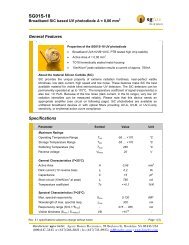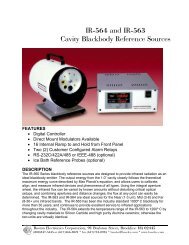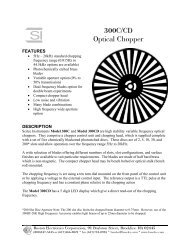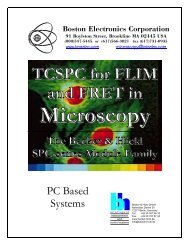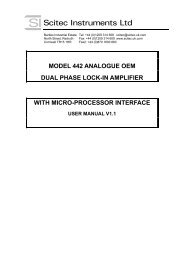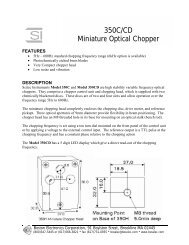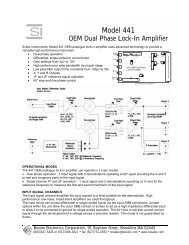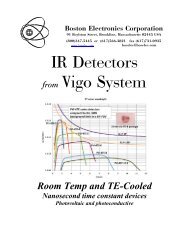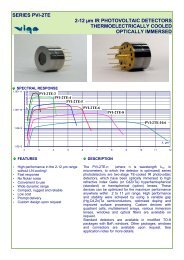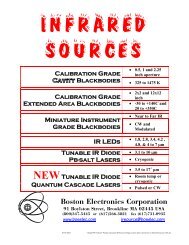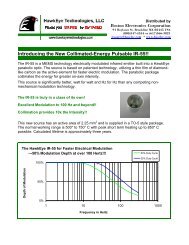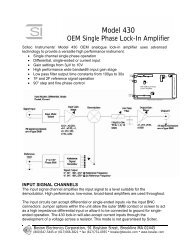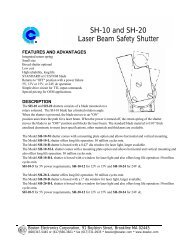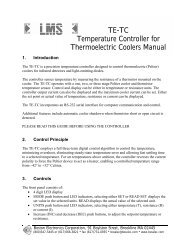sg01L-18 SiC Photodiode - Boston Electronics Corporation
sg01L-18 SiC Photodiode - Boston Electronics Corporation
sg01L-18 SiC Photodiode - Boston Electronics Corporation
You also want an ePaper? Increase the reach of your titles
YUMPU automatically turns print PDFs into web optimized ePapers that Google loves.
•fSG01L-<strong>18</strong>Broad Band <strong>SiC</strong> based UV photodiode A = 0,96mm 2General FeaturesProperties of the SG01L-<strong>18</strong> UV photodiode• Broad Band UVA+UVB+UVC photodiode• Active Area A = 0,96 mm 2• TO<strong>18</strong> hermetically sealed metal housing• 10µW/cm 2 peak radiation results a current of approx. 12nAAbout the material Silicon Carbide (<strong>SiC</strong>)<strong>SiC</strong> provides the unique property of near-perfect visible blindness, low dark current, highspeed and low noise. These features make <strong>SiC</strong> the best available material for visible blindsemiconductor UV detectors. Some <strong>SiC</strong> detectors (our HT-series) can be permanentlyoperated at up to 170°C. The temperature coefficie nt of signal (responsivity) is also low,10 10 -Rev. 4.0 specifications subject to change without notice Page 1 [2]Manufacturer: sglux GmbH; Agent: <strong>Boston</strong> <strong>Electronics</strong>, 91 Boylston St, Brookline MA 02445 USA(800) 3475445 or (617) 5663821; fax (617) 7310935; uv@boselec.com ; www.boselec.com
SG01L-<strong>18</strong>Broad Band <strong>SiC</strong> based UV photodiode A = 0,96mm 2Spectral ResponseCircuitViewing AngleDrawingRev. 4.0 specifications subject to change without notice Page 2 [2]Manufacturer: sglux GmbH; Agent: <strong>Boston</strong> <strong>Electronics</strong>, 91 Boylston St, Brookline MA 02445 USA(800) 3475445 or (617) 5663821; fax (617) 7310935; uv@boselec.com ; www.boselec.com
••Application Note for <strong>Photodiode</strong>sApplication NoteFor correct reading of the photodiode the current (and NOT the voltage) must be analyzed.This requires a short circuiting of the photodiode. Usual approaches are using aPicoamperemeter such as Keithley 617 or a transimpedance amplifier circuit as shown onpage 2 of this datasheet. Please contact us in case of questions.The below listed modules help you to get the best measurement information from yourphotodiode.Internal & external <strong>Photodiode</strong> Amplifiersa• stable and reliable photodiode amplification• TOCON-Series = photodiodes with integrated amplifier• BOARD-Series = external photodiode amplifiers• further information: www.sglux.com/tocon orwww.sglux.com/boardsUV probes with built in amplifiera• different housings e.g. with cosine response, water pressureproof or Sapphire windows• different electronic outputs available (voltage, current, USB)• further information: www.sglux.com/probesUV Intensity / Dose Monitor / Controller“SENSOR MONITOR”• two channel photodiode or sensor input• three user programmable relay outputs• programmable display, USB/TTY/RS232 data transmission• further information: www.sglux.com/monitoraUV Radiation Controller “RADIKON”a• Industrial DIN rail radiation controller module• works with mV and nA….mA sensor output signals• further information: www.sglux.com/radikonRev. 3.0Appendix AManufacturer: sglux GmbH; Agent: <strong>Boston</strong> <strong>Electronics</strong>, 91 Boylston St, Brookline MA 02445 USA(800) 3475445 or (617) 5663821; fax (617) 7310935; uv@boselec.com ; www.boselec.com



